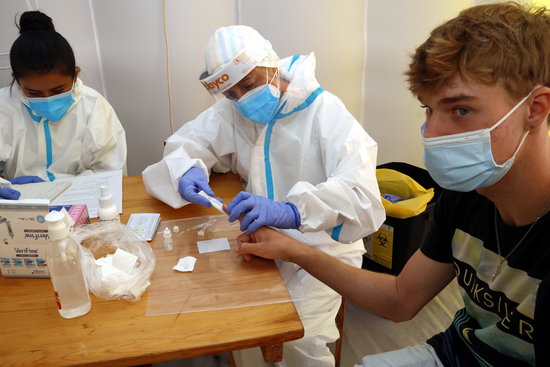38-years-old, low income, asymptomatic: the new profile of the average Covid-19 patient
Both genders equally affected, while rural and urban areas suffer new cases with similar intensity

During the first weeks of the pandemic in Catalonia, in early spring, the profile of the average Covid-19 patient was a woman in her fifties living in an urban area.
Yet, the latest outbreaks, starting in July, have changed the story considerably, as those diagnosed in the past few weeks are younger, and therefore generally less serious patients, and live both in rural and urban areas.
Like during the beginning of the pandemic, at least in Barcelona, those living in areas with a lower socioeconomic level are worse affected by the virus, but that gap has now widened.
Lower average age
According to the website where the Catalan health department releases its Covid-19 figures every day, the average age of those testing positive was 38 from August 23 to August 29, following the same trend started when the outbreaks began in early July.
The average patient age throughout the whole pandemic since March is now 50, a number that has been decreasing since July.
In the first weeks of the health emergency, the age range of 50-79 year-olds was registering the highest number of confirmed cases.
Bigger share of asymptomatic cases
Elderly people are usually the most badly affected by Covid-19, and since the average age of those diagnosed has gone down, so has the impact of the disease on new patients.
In the worst moment of the health crisis, 1,529 people were in intensive care at the one time, whereas in the second wave, the figure has reached 138, ten times less – a decrease repeated with the number of those hospitalized.
The share of asymptomatic cases is higher, therefore authorities have launched targeted mass screenings to find positives who might not have noticed the disease in their body.
While in the spring the situation in care homes was dramatic, the social affairs minister, Chakir el Homrani, said on Wednesday that the figures in such centers for elderly people are now "below average."
Spain's director of health emergencies, Fernando Simón, said that those below 20 years of age is the demographic with the second most amount of diagnoses now in the whole of Spain, with those around 30 coming first.
Both rural and urban areas
Since July, both rural and urban areas have been remarkably affected by Covid-19.
The first region with outbreaks in the summer was Lleida, the least populated region but for the Ebre river area and the western Pyrenees.
The second one was the Barcelona metropolitan area, which accounts for almost two-thirds of the country's population.
As of August 29, the risk of outbreak is considered high in 29 out of the 42 counties across Catalonia, including the areas closest to the capital, but also rural inland areas of the Lleida, Girona, and Tarragona regions.
Only the western Pyrenees, the southern area of the Ebre river region, and some counties in the northeast have a lower level of outbreak risk.
Similarly, in the week of August 23-29, several metropolitan or densely populated counties featured in the top 15 counting cases per 100,000 inhabitants, including Barcelonès and Baix Llobregat – yet, a number of the counties topping the ranking were mostly rural, such as La Noguera, Garrigues and Alt Urgell, the top three.
Lower incomes, more affected
What remains unchanged is that areas with a lower socioeconomic level report more cases than wealthier ones, at least in the city of Barcelona – and the gap is now wider.
The Catalan capital's public health agency breaks down the figures for the city with different criteria, one of them being the socioeconomic level.
The findings show that between July 1 and August 31, those falling in the last quantile in terms of income registered a ratio of between 931 (women) and 1,019 (men) cases per 100,000 inhabitants.
The ratio decreases as salaries increase, and those in the first quantile oscillate between 382 (women) and 425 (men) cases per 100,000 inhabitants.
From March until June, ratios of all quantiles usually moved between 550 and 800 positives per 100,000 inhabitants.
Both genders equally affected
While more women tested positive in the earlier stages of the pandemic, this figure has balanced now.
The health ministry figures show that, in the August 23 to August 29 week, 49.4% of those affected were women, and the figure on the previous week was 50.4% – yet, the average from March to now is still 55% women, 45% men.